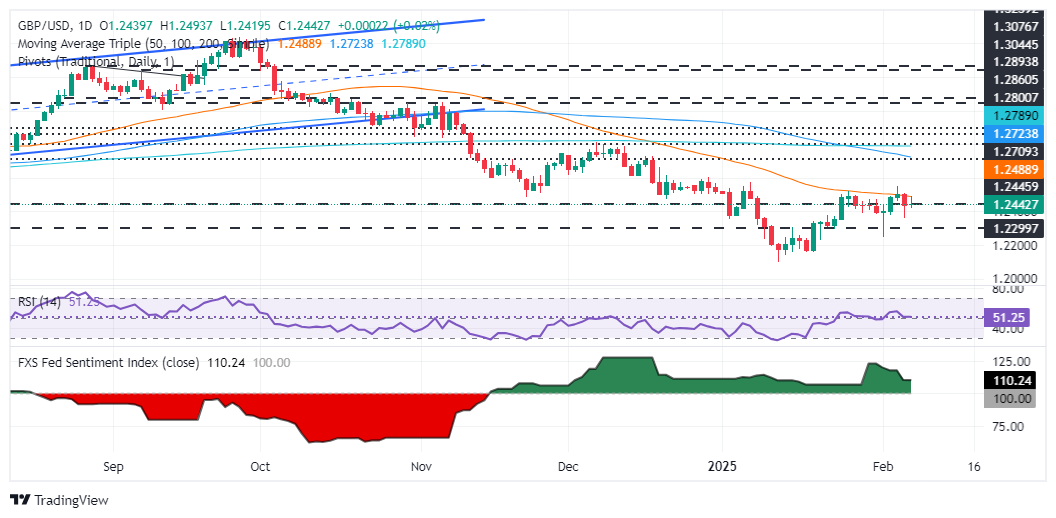GBP/USD holds to earlier gains near 1.2450 post US jobs data
- GBP/USD ascends to 1.2451, buoyed by disappointing US NFP figures showing only 143K jobs added.
- US unemployment rate improves to 4%, with a notable increase in Average Hourly Earnings hinting at robust consumer spending.
- Market anticipates Fed rate cut in June 2025, while recent BoE rate cut minimally impacts Pound's performance.
The Pound Sterling registered gains versus the US Dollar on Friday following a softer-than-expected US Nonfarm Payrolls report. The GBP/USD seesawed within a 1.2418 – 1.2491 range and traded at 1.2451, up 0.15%.
The Pound appreciates following a weak US jobs report
January US NFP data was softer than expected, with the economy adding 143K people to the workforce, below the 170K estimated. The Unemployment Rate ticked lower from 4.1% to 4%, a sign that the labor market remains strong. At the same time, Average Hourly Earnings surged, which would likely keep consumer spending strong.
Following the data, futures linked to the Fed funds rate showed that traders estimate the Fed’s first rate cut in 2025 will be in June, as expected following the US Central Bank's first policy meeting.
Meanwhile, the Pound remained unfazed after the Bank of England (BoE) cut rates by 25 basis points on Thursday, reducing the interest rate differential between the US and the UK.
Recently, the University of Michigan revealed that Consumer Sentiment deteriorated in its preliminary February reading, with the index dipping from 71.1 to 57.8, as expected.
GBP/USD Price Forecast: Technical outlook
The GBP/USD downtrend remains intact, but in the short term, it could rise toward the 50-day Simple Moving Average (SMA) at 1.2493. If buyers clear the latter the 1.2500 psychological level is up next.
Momentum turned bullish, as depicted by the Relative Strength Index (RSI). If GBP/USD achieves a daily close above 1.2500, buyers could drive the exchange rate to its December 30 peak of 1.2607.
On the other hand, if GBP/USD tumbles below 1.2450, the next support would be the February 6 swing low of 1.2359, ahead of 1.2300.

Pound Sterling FAQs
The Pound Sterling (GBP) is the oldest currency in the world (886 AD) and the official currency of the United Kingdom. It is the fourth most traded unit for foreign exchange (FX) in the world, accounting for 12% of all transactions, averaging $630 billion a day, according to 2022 data. Its key trading pairs are GBP/USD, also known as ‘Cable’, which accounts for 11% of FX, GBP/JPY, or the ‘Dragon’ as it is known by traders (3%), and EUR/GBP (2%). The Pound Sterling is issued by the Bank of England (BoE).
The single most important factor influencing the value of the Pound Sterling is monetary policy decided by the Bank of England. The BoE bases its decisions on whether it has achieved its primary goal of “price stability” – a steady inflation rate of around 2%. Its primary tool for achieving this is the adjustment of interest rates. When inflation is too high, the BoE will try to rein it in by raising interest rates, making it more expensive for people and businesses to access credit. This is generally positive for GBP, as higher interest rates make the UK a more attractive place for global investors to park their money. When inflation falls too low it is a sign economic growth is slowing. In this scenario, the BoE will consider lowering interest rates to cheapen credit so businesses will borrow more to invest in growth-generating projects.
Data releases gauge the health of the economy and can impact the value of the Pound Sterling. Indicators such as GDP, Manufacturing and Services PMIs, and employment can all influence the direction of the GBP. A strong economy is good for Sterling. Not only does it attract more foreign investment but it may encourage the BoE to put up interest rates, which will directly strengthen GBP. Otherwise, if economic data is weak, the Pound Sterling is likely to fall.
Another significant data release for the Pound Sterling is the Trade Balance. This indicator measures the difference between what a country earns from its exports and what it spends on imports over a given period. If a country produces highly sought-after exports, its currency will benefit purely from the extra demand created from foreign buyers seeking to purchase these goods. Therefore, a positive net Trade Balance strengthens a currency and vice versa for a negative balance.
